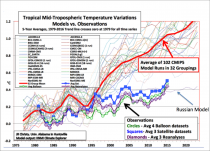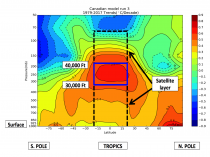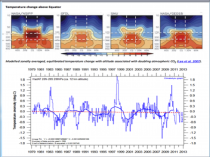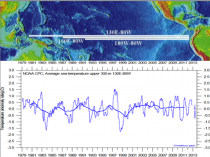This BAMS special report presents assessments of how human-caused climate change may have affected the strength and likelihood of individual extreme events.
In any given year you can find extremes of all kinds. Anthropogenic Climate Change is usually attributed as the reason for the events, with metal gymnastics employed. All extremes - heat and cold, wet and dry, more hurricanes, fewer hurricanes , more tornadoes, fewer tornadoes, more snow, less snow, more Ice, less ice, slower sea level rise/ larger sea level rises are all attributed to CO2 warming. It is a non falsifiable hypothesis.
We assembled true climate experts in each extreme weather phenomena and they have objectively looked at US extremes attributed to man here - you see the claims can be explained by natural factors or when man is involved, it is related to bad policies based on failing theories. Please help support our efforts to keep this up to date (DONATE BUTTON is on the left column. The work has been done by all pro bono. Rest assured the cash flow on the alarmist side is constant and abundant. Sadly most all energy companies, the auto companies, manufacturing and most industries have all prematurely thrown in the towel on this issue. We will all pay the price later on unless we can turn opinion around by getting the truth out.
The models are failing as John Christy explained in this WUWT story by David Middleton.
This is a full transcript of a talk given by Dr John Christy to the GWPF on Wednesday 8th May.
When I grew up in the world of science, science was understood as a method of finding information. You would make a claim or a hypothesis, and then test that claim against independent data. If it failed, you rejected your claim and you went back and started over again. What I’ve found today is that if someone makes a claim about the climate, and someone like me falsifies that claim, rather than rejecting it, that person tends to just yell louder that their claim is right. They don’t look at what the contrary information might say.
OK, so what are we talking about? We’re talking about how the climate responds to the emission of additional greenhouse gases caused by our combustion of fossil fuels.
[....]
So here’s the deal. We have a change in temperature from the deep atmosphere over 37.5 years, we know how much forcing there was upon the atmosphere, so we can relate these two with this little ratio, and multiply it by the ratio of the 2x CO2 forcing. So the transient climate response is to say, what will the temperature be like if you double CO2 - if you increase at 1% per year, which is roughly what the whole greenhouse effect is, and which is achieved in about 70 years. Our result is that the transient climate response in the troposphere is 1.1 C. Not a very alarming number at all for a doubling of CO2. When we performed the same calculation using the climate models, the number was 2.31C. Clearly, and significantly different. The models’ response to the forcing [- their delta T here, was over 2 times greater than what has happened in the real world.

(note the actual temperature profile matches the non greenhouse gas model profile)

[...]
There is one model that’s not too bad, it’s the Russian model. You don’t go to the White House today and say, “the Russian model works best”. You don’t say that at all! But the fact is they have a very low sensitivity to their climate model. When you look at the Russian model integrated out to 2100, you don’t see anything to get worried about. When you look at 120 years out from 1980, we already have 1/3 of the period done - if you’re looking out to 2100. These models are already falsified, you can’t trust them out to 2100, no way in the world would a legitimate scientist do that. If an engineer built an aeroplane and said it could fly 600 miles and the thing ran out of fuel at 200 and crashed, he might say: “I was only off by a factor of three”. No, we don’t do that in engineering and real science! A factor of three is huge in the energy balance system. Yet that’s what we see in the climate models.
I have three conclusions for my talk:
Theoretical climate modelling is deficient for describing past variations. Climate models fail for past variations, where we already know the answer. They’ve failed hypothesis tests and that means they’re highly questionable for giving us accurate information about how the relatively tiny forcing, and that’s that little guy right there, will affect the climate of the future.
The weather we really care about isn’t changing, and Mother Nature has many ways on her own to cause her climate to experience considerable variations in cycles. If you think about how many degrees of freedom are in the climate system, what a chaotic nonlinear, dynamical system can do with all those degrees of freedom, you will always have record highs, record lows, tremendous storms and so on. That’s the way that system is.
And lastly, carbon is the world’s dominant source of energy today, because it is affordable and directly leads to poverty eradication as well as the lengthening and quality enhancement of human life. Because of these massive benefits, usage is rising around the world, despite calls for its limitation.
And with that I thank you very much for having me.
GWPF
Note it has been shown the greenhouse models share a common element - a tropical hotspot at 30-40,000 feet seen in the model but not in the satellite or balloon data. Nor is there any warming seen in the oceans beneath.





